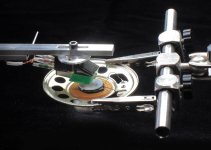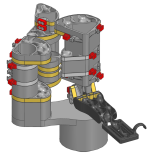Some of this is above my pay grade, but I have calculated EM for several arms. IMO, the problem for most is that they didn't build the arm and therefore don't know the mass of the various parts. Often you can't take it apart to measure. To me, that suggests some different method than calculation is needed. One thought I've had is to use a small piezoelectric block, or maybe a small speaker, and excite the thing through a load cell. Force and frequency should get you the EM.
A simplified formula for PTAs?
Seems too good to be true, to me - my old drawing shows instead a very complex situation to deal with
carlo
I went to much off topic. I apologize to our friend 2wice
Seems too good to be true, to me - my old drawing shows instead a very complex situation to deal with
carlo
I went to much off topic. I apologize to our friend 2wice
Last edited:
Conrad,
I think the speaker excitation method you posted was part of the discussion where Hakkaplan posted his static test. I’d forgotten that. I thought the dynamic test was a good approach, but because the static test is so much simpler and seems to work, I never followed up.
Carlo,
The dynamic test - applied to four or five equidistant spots across the Thales circle - might answer, or at least give a hint, about PLT effM.
2wice,
I hope your OP means you’re working on a new design.
Doug
I think the speaker excitation method you posted was part of the discussion where Hakkaplan posted his static test. I’d forgotten that. I thought the dynamic test was a good approach, but because the static test is so much simpler and seems to work, I never followed up.
Carlo,
The dynamic test - applied to four or five equidistant spots across the Thales circle - might answer, or at least give a hint, about PLT effM.
2wice,
I hope your OP means you’re working on a new design.
Doug
That was quick. That’s what I thought was being suggested. Have you tried a signal through it yet?
Doug
Doug
yes - it was just an attempt to bypass the uncertainties of the signal on the test disk; so we got those of the loudspeaker in exchange.
Tried (also without the cartridge) for wand resonances not EM calc.
c
Tried (also without the cartridge) for wand resonances not EM calc.
c
2wice,
I hope your OP means you’re working on a new design.
Doug
Hi Doug
Maybe. 😛
I've been out the loop for a long time, got smacked by life, 3 jobs and material science, but I found some solutions to problems that I could not overcome previously.
Every time I thought I know what was going on, I was proven wrong. Hopefully back on track now with something to show for 7 years of work.
Attachments
Hope you put all this behind, 2wice, and to see your innovative ideas as soon.
Many diyers owe a lot to your designs, your knowledge, your disposability; e.g. without your precious help my Rabbit PLT geometry could never have been tuned up.
Ciao - Carlo
Many diyers owe a lot to your designs, your knowledge, your disposability; e.g. without your precious help my Rabbit PLT geometry could never have been tuned up.
Ciao - Carlo
Thank you for your kind words Carlo, but none of us can hold a candle to your own prodicious creativity.
- Home
- Source & Line
- Analogue Source
- Effective Mass Method

